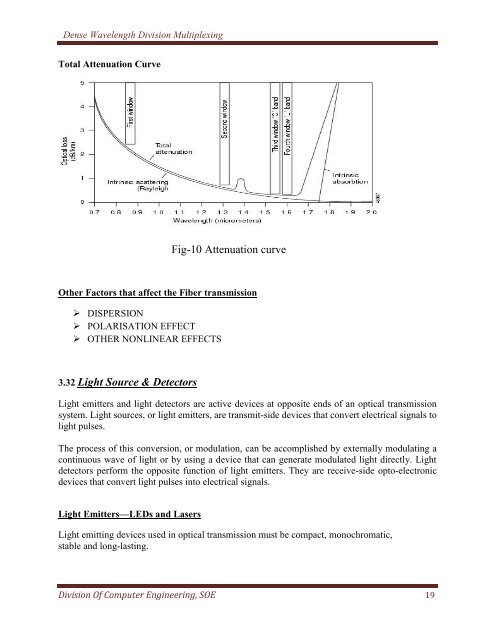Dense Wavelength Division Multiplexing - DSpace at CUSAT ...
Dense Wavelength Division Multiplexing - DSpace at CUSAT ...
Dense Wavelength Division Multiplexing - DSpace at CUSAT ...
You also want an ePaper? Increase the reach of your titles
YUMPU automatically turns print PDFs into web optimized ePapers that Google loves.
<strong>Dense</strong> <strong>Wavelength</strong> <strong>Division</strong> <strong>Multiplexing</strong><br />
Total Attenu<strong>at</strong>ion Curve<br />
Fig-10 Attenu<strong>at</strong>ion curve<br />
Other Factors th<strong>at</strong> affect the Fiber transmission<br />
DISPERSION<br />
POLARISATION EFFECT<br />
OTHER NONLINEAR EFFECTS<br />
3.32 Light Source & Detectors<br />
Light emitters and light detectors are active devices <strong>at</strong> opposite ends of an optical transmission<br />
system. Light sources, or light emitters, are transmit-side devices th<strong>at</strong> convert electrical signals to<br />
light pulses.<br />
The process of this conversion, or modul<strong>at</strong>ion, can be accomplished by externally modul<strong>at</strong>ing a<br />
continuous wave of light or by using a device th<strong>at</strong> can gener<strong>at</strong>e modul<strong>at</strong>ed light directly. Light<br />
detectors perform the opposite function of light emitters. They are receive-side opto-electronic<br />
devices th<strong>at</strong> convert light pulses into electrical signals.<br />
Light Emitters—LEDs and Lasers<br />
Light emitting devices used in optical transmission must be compact, monochrom<strong>at</strong>ic,<br />
stable and long-lasting.<br />
<strong>Division</strong> Of Computer Engineering, SOE 19

















